Phthalates and asthma in children and adults: US NHANES 2007-2012
- PMID: 31368075
- PMCID: PMC6791917
- DOI: 10.1007/s11356-019-06003-2
Phthalates and asthma in children and adults: US NHANES 2007-2012
Erratum in
-
Correction to: Phthalates and asthma in children and adults: US NHANES 2007-2012.Environ Sci Pollut Res Int. 2020 Apr;27(10):11459. doi: 10.1007/s11356-020-07869-3. Environ Sci Pollut Res Int. 2020. PMID: 32026183 Free PMC article.
Abstract
Environmental exposure to phthalates may contribute to an increased risk of asthma in children and adults. We aimed to assess the direction and strength of the association between urinary phthalates metabolites and current asthma in children and adults that participated in the National Health and Nutrition Examination Survey (NHANES) 2007-2012. Data on ten urinary phthalate metabolites, self-reported questionnaires, spirometry measures, and covariates were obtained from 7765 participants (28.1% were children aged 6-17 years) taking part in the NHANES 2007-2012. Asthma was assessed using self-reported questionnaires for children and adults, and via spirometry measures for adults alone. We used crude and adjusted logistic regression models to estimate the odds ratios (ORs) and 95% confidence interval (CI) per one log10 unit change in the concentration of phthalate metabolites. We further modeled the effect modification by sex. Out of 10 metabolites, only mono-benzyl phthalate (MBzP) was positively associated with the prevalence of self-reported asthma in children, after adjusting for a range of potential confounders (odds ratio 1.54; 95% confidence interval 1.05-2.27). No significant relationship was observed for adults. The association of mono-ethyl phthalate (MEP) was modified by sex, with significantly increased odds of asthma among males [boys (2.00; 1.14-3.51); adult males (1.32; 1.04-1.69)]. While no other phthalates showed a positive relationship with current asthma in males, mono-(carboxynonyl) phthalate (MCNP) and mono-(3-carboxylpropyl) phthalate (MCPP) were inversely associated with spirometrically defined asthma in adult females. A sex-specific relationship in adults was evident when spirometry, but not self-reported measures were used to define asthma. We found no clear association between exposure to phthalates and current asthma, except for a significant relationship between MBzP metabolites and self-reported asthma in children. As a result, exposure to phthalates and asthma development and/or exacerbations remains controversial, suggesting a need for a well-designed longitudinal study.
Keywords: Adult asthma; Childhood asthma; Mono-benzyl phthalate; NHANES; Phthalate metabolites.
Conflict of interest statement
The authors declare that they have no competing interests.
Figures
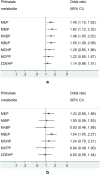
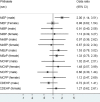
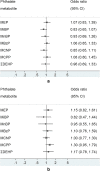
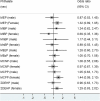
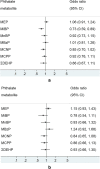
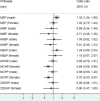
Similar articles
-
Age and sex differences in childhood and adulthood obesity association with phthalates: analyses of NHANES 2007-2010.Int J Hyg Environ Health. 2014 Jul;217(6):687-94. doi: 10.1016/j.ijheh.2014.02.005. Epub 2014 Mar 5. Int J Hyg Environ Health. 2014. PMID: 24657244 Free PMC article.
-
Biomonitoring of phthalate metabolites in the Canadian population through the Canadian Health Measures Survey (2007-2009).Int J Hyg Environ Health. 2013 Nov;216(6):652-61. doi: 10.1016/j.ijheh.2012.12.009. Epub 2013 Feb 16. Int J Hyg Environ Health. 2013. PMID: 23419587
-
Association between urinary phthalate metabolites and chronic obstructive pulmonary disease incidence in US adults: results from NHANES 2007-2018.Environ Sci Pollut Res Int. 2023 Nov;30(52):113026-113038. doi: 10.1007/s11356-023-30334-w. Epub 2023 Oct 17. Environ Sci Pollut Res Int. 2023. PMID: 37848781
-
The association between phthalate exposure and asthma.Kaohsiung J Med Sci. 2012 Jul;28(7 Suppl):S28-36. doi: 10.1016/j.kjms.2012.05.007. Epub 2012 Jul 12. Kaohsiung J Med Sci. 2012. PMID: 22871598 Free PMC article. Review.
-
"Oxidative stress induced by phthalates in mammals: State of the art and potential biomarkers".Environ Res. 2022 Apr 15;206:112636. doi: 10.1016/j.envres.2021.112636. Epub 2021 Dec 29. Environ Res. 2022. PMID: 34973198 Review.
Cited by
-
Association Between Life's Essential 8 and Frailty in Adults with Asthma.Dose Response. 2025 May 27;23(2):15593258251342829. doi: 10.1177/15593258251342829. eCollection 2025 Apr-Jun. Dose Response. 2025. PMID: 40438707 Free PMC article.
-
The association between urinary phthalate metabolites and serum thyroid function in US adolescents.Sci Rep. 2023 Jul 18;13(1):11601. doi: 10.1038/s41598-023-38644-2. Sci Rep. 2023. PMID: 37463966 Free PMC article.
-
Association between urinary phthalate metabolites and Anemia in US adults.Sci Rep. 2024 Sep 9;14(1):21041. doi: 10.1038/s41598-024-72147-y. Sci Rep. 2024. PMID: 39251808 Free PMC article.
-
The J-shaped relationship between body roundness index and adult asthma: insights from NHANES 2001-2018.Front Nutr. 2025 Mar 20;12:1516003. doi: 10.3389/fnut.2025.1516003. eCollection 2025. Front Nutr. 2025. PMID: 40181938 Free PMC article.
-
Association between dietary antioxidants intake and childhood eczema: results from the NHANES database.J Health Popul Nutr. 2024 Jan 18;43(1):12. doi: 10.1186/s41043-024-00501-x. J Health Popul Nutr. 2024. PMID: 38238860 Free PMC article.
References
-
- Alfardan AS, Nadeem A, Ahmad SF, Al-Harbi NO, Al-Harbi MM, AlSharari SD. Plasticizer, di (2-ethylhexyl) phthalate (DEHP) enhances cockroach allergen extract-driven airway inflammation by enhancing pulmonary Th2 as well as Th17 immune responses in mice. Environ Res. 2018;164:327–339. - PubMed
-
- Almqvist C, Worm M, Leynaert B. Impact of gender on asthma in childhood and adolescence: a GA2LEN review. Allergy. 2008;63(1):47–57. - PubMed
-
- Asher MI, Montefort S, Björkstén B, Lai CKW, Strachan DP, Weiland SK, Williams H. Worldwide time trends in the prevalence of symptoms of asthma, allergic rhinoconjunctivitis, and eczema in childhood: ISAAC Phases One and Three repeat multicountry cross-sectional surveys. Lancet. 2006;368(9537):733–743. - PubMed
-
- Bai PY, Wittert G, Taylor AW, Martin SA, Milne RW, Jenkins AJ, Januszewski AS, Shi Z. The association between total phthalate concentration and non-communicable diseases and chronic inflammation in South Australian urban dwelling men. Environ Res. 2017;158:366–372. - PubMed
MeSH terms
Substances
Grants and funding
LinkOut - more resources
Full Text Sources
Medical
Research Materials

